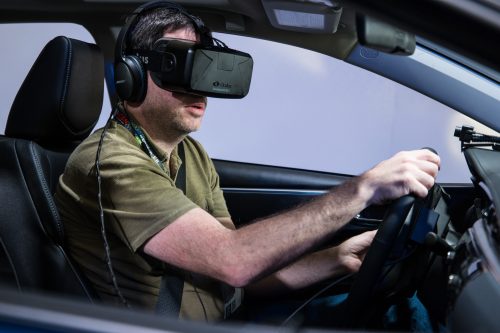Why virtual reality will not soon replace the motion pictures

By David Fogg. The article is published with the approval of Scientific American Israel and the Ort Israel network 26.07.2016
Tech headlines have declared 2016 to be the year of virtual reality (VR). Every self-respecting multi-billion dollar corporation is already competing with its peers in a wild run into the virtual reality helmet market (Sony, Samsung, Google, Microsoft, HTC). And since Facebook acquired the young virtual reality company in 2014 Oculus At a price of 2 billion dollars, the journalists and investors became part of the madness.
Using binoculars that project images in full screen, this technology allows you to completely immerse yourself in another world. When you turn your head in any direction, your "photo angle" changes - an obvious tool in games. Why shoot only at the aliens coming in front of you if you can also shoot back?
But in the opinion of the promoters of the technology, in the next phase will come virtual reality movies. Fox, Disney and Lionsgate have already committed to investing huge sums in the production of 360 degree films.
According to the devotees, the traditional films will look poor compared to these new immersive films. "Even the greatest cinematic achievements control the viewer tyrannically, by their very nature,"Written on the innovation site Digital Trends. "It is the camera that dictates what you see," the reporter complained. Oh my... who wants that?
And according to another site, Gizmodo, the virtual reality films presented at this year's Sundance Film Festival may be "The first nails In the coffin of the flats." (Flatties is a derogatory term for traditional films.) OK. VR movies, which you can look around while watching, will replace the flat movies, which are boring and overbearing movies. Right?
no and no.
In the near term, it is easy to see why this is not going to happen. VR equipment is expensive ($600 for an Oculus Rift helmet and another $1,000 for a compatible computer). And the helmet is way too heavy to wear on your face for a two hour movie.
Then comes the technical challenge. VR movies are terrifyingly difficult to script. Even when shooting a flat film, it takes a tremendous amount of effort to make sure that the lighting equipment, crew and vehicles stay out of the picture frame. Where will you hide your equipment, lighting and crew when the camera is shooting 360 degrees around you?
But all this is "small money" compared to the huge problem that no VR filmmaker has been able to solve: keeping the audience's attention.
A film director does more than direct the actions of the actors. It also directs your attention through camera angles, lighting, selective focus and even sounds that create a desired effect. A film is a story that everyone experiences in the same way because everyone witnesses the same events.
Where can we look at a spherical film? How can the director make sure that we look to the right and see the reveal of the villain's true face, if at that exact moment we are busy examining the skeleton of the wrecked car lying behind us?
And this is exactly the problem you will encounter if you watch one of the first virtual reality movies. In the short VR film back water, which was filmed in 360 degrees and financed by the Mini car manufacturer, the protagonist pushes a production worker into a scrap pile and runs away from the camera. I was still actually watching, wondering if he was okay, when a crashing noise out of (my) field of vision told me that I had just missed the next important action event in the movie.

Sometimes there is a graphic sign that guides you where to turn your head, like the firefly in the movie Lost, an Oculus VR animation reminiscent of Pixar's films, or Arrows in some Experimental VR videos of the New York Times.
But most VR "movies" don't really have a plot. Someone threw a panoramic camera in some interesting place - a market, a ship, a sporting event - and you can just look around.
It surrounds you from all sides and it's interesting. And some of the games are exceptionally cool. But they don't tell a story. It's not a movie.
History teaches us two things about new technologies that were supposed to change our lives. First, they end up in narrow niches and rarely become useful in any home. (See also: XNUMXD printers and bending, that is the sagway.) Second, inventions rarely replace their predecessors as envisioned for them. Usually they are just added.
So yes, there are already some successful VR videos, VR games, VR shows, VR real estate “tours” and VR city tours. One day there will also be games that combine movies.
But virtual reality will remain an entertaining experience, similar to IMAX movies or those hydraulic "four-dimensional" installations in amusement parks, shopping malls and science museums. Until someone comes along who finds a way to tell all viewers in virtual reality the same story, our flat and depressing movies will continue to be our cinema

5 תגובות
A.
Obscuring part of the image will damage immersion - very quickly the viewer will learn not to turn around. How did he know there was now a picture on the back?
There is another serious problem with the film, and that is that in VR you cannot rotate the image. The camera should be static, or move at a constant speed. When you are "inside" the virtual world, the body expects to feel the accelerations it sees. On a flat screen, the frame gives a reference system that avoids this problem.
The problem of the cinema can be improved at least partially by surround sound which is still not common today on all platforms. This is how the heart node can be focused by the sound. Another possibility is to give up full 360 and show only a part of the film and darken the rest, as is sometimes done in the theater where a part of the stage is darkened. And in the honesty of Nof, for example, open all 360.
Some notes
It is too early to say that 10D printers have failed. What's more, it seems that the technology still has a lot to improve (simplicity of operation, the length of time, the price of the device and the material) and even complaints about the smell are what blocks the technology more than lack of interest. I'm sure that within 20-XNUMX it will enter most homes. The Sagway will also enter in the end without a doubt but in a different configuration, as a vehicle the size of a laptop.
The question about virtual reality is whether the technology is ripe and whether even when it is ripe it will be able to bring about a revolution. So you have to remember that cinema is only a very small part of what is expected from VR. The big profits will come first from computer games (a field that has long overtaken the film industry in terms of profits) the pornography industry will also probably adopt very quickly and the next turn will be sports broadcasting
The writer mixes two things - virtual reality systems, 360 movies, and even completely ignores the world of augmented reality.
I agree that 360 movies are not serious and will not replace the world of flat movies. It's good maybe for nature movies and niche movies.
The world of virtual reality is already bringing in money in the field of games, in industry (architecture for example) and even in the field of medicine.
Augmented reality is still in its infancy, but it will advance in parallel with virtual reality and even overcome it in certain fields of industry, and especially in the world of medicine...
As someone who really likes the science site, I think that whoever wrote the article, does not understand the field of virtual/augmented reality.
I would be happy to write accurate articles on the subject, you are also welcome to read articles on virtual reality on the Internet.
The future is virtual and augmented reality!